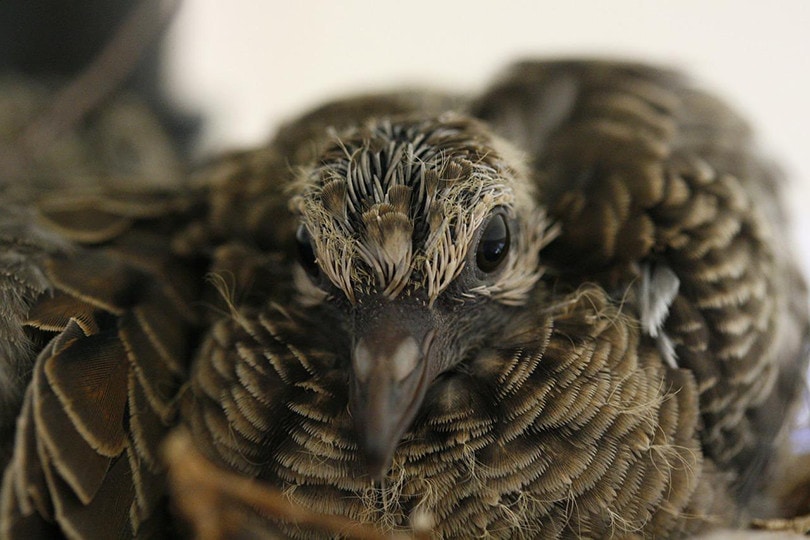What to Feed Baby Mourning Doves – 3 Great Options
Last Updated on

For the first week of its life, a baby mourning dove eats only crop milk. Male or female doves can make this food in their crops. After the first week, the baby begins eating partially digested seeds from mom or dad. Then around weeks 3 or 4, the baby dove begins eating seeds on its own.
Proper identification is important if you end up having to feed a baby mourning dove because that will determine how and what you can feed them. Because sometimes, things happen, and a baby falls from the nest or is abandoned by its parents. If this happens, you may become an unexpected mourning dove parent for a few weeks.
Here are several things you can try as far as feeding is concerned.
What to Feed Baby Mourning Doves
1. Parrot Formula
A mourning dove’s diet consists almost entirely of seeds. However, because the baby can’t actually eat seeds by themselves for close to a month, you need something else. Parrots are also seed-eating birds, so picking up parrot food formula is one of the best options for feeding a baby mourning dove.
Other than mixing the food according to the directions, the key factor in whether the dove will eat is based on temperature. To get the bird to eat, you’ll want to aim for a formula temperature of around 105° F (40.5° C).
A few steps to formula-feeding a baby mourning dove:
- Fill a small syringe with warm formula and gently touch the dove’s beak.
- When they open their mouth, pay attention to the small sack under the beak—this is called the crop. When this is full, stop feeding the bird.
- You’ll want to repeat this process every few hours. A good rule of thumb is that the baby bird is hungry if the crop is empty.
Side note: There’s no need to give the baby dove water because the formula meets their water needs. Forcing the bird to drink in the same way you’re feeding it can actually cause it to drown.

2. Hand-Fed Seeds
By refusing the formula, the baby mourning dove will let you know when it’s ready for solid food. At this point, it’s time to introduce some seeds. However, the baby dove won’t know what to do, so it’s up to you to show it.
First, you’ll start by hand-feeding seeds a couple at a time. If the baby won’t open its mouth for you, gently open it and pop a couple of seeds in. Again, pay attention to the crop because once it’s full, you need to stop feeding.
3. Self-Fed Seeds
After being hand-fed a few times, the baby will likely be willing to get its own food. All you need to do is put some seeds on the floor of its cage. After it pecks food off the ground, double-check that it’s actually filling its crop. If the baby isn’t swallowing correctly by itself, you’ll need to continue hand-feeding for a bit longer.

Seeds for Mourning Doves
Even adult mourning doves do not have large beaks. So, these birds don’t typically eat large seeds that require cracking or opening. This is especially true for a baby bird. Here are a few options for good seeds to feed the baby:
- Safflower seeds
- Proso millet (white)
- Cracked corn
- Sunflower seeds (shelled preferably)

Things That Factor Into Baby Mourning Dove Safety
Feeding a baby mourning dove isn’t complicated, but it’s important to their survival if mom and dad aren’t around. There are a couple of other things to remember if you’re left rearing a baby dove.
Temperature
Depending on when a baby was left without parents and a nest, they may need extra care regarding temperature. A fledgling mourning dove takes 12 to 15 days to become fully feathered. Once they have all their feathers, they are less prone to harm from cooler temperatures. At this point, they are typically almost ready to be on their own as well.

Ensure the Baby Mourning Dove Can Fly
Even if the mourning dove is eating fine on its own. You need to ensure that it can fly well before setting it free. Flight is critical to survival once the baby is in the wild. If it can’t fly well, it won’t be able to access all the available food or water. But more than that, it won’t be able to evade predators such as cats or birds of prey.

Closing Thoughts
Nature can be cruel, and sometimes it needs human intervention to thrive. In the case of a baby mourning dove, they almost certainly won’t survive if they are left alone by their parents before 2 weeks old. If this happens, a little care from you could make the difference. But if you’re unable to or don’t want to, there are wildlife rehabilitators in some areas. These people specialize in helping wild animals survive.
Featured Image Credit: jaredcaraway, Pixabay
About the Author Robert Sparks
Robert’s obsession with all things optical started early in life, when his optician father would bring home prototypes for Robert to play with. Nowadays, Robert is dedicated to helping others find the right optics for their needs. His hobbies include astronomy, astrophysics, and model building. Originally from Newark, NJ, he resides in Santa Fe, New Mexico, where the nighttime skies are filled with glittering stars.
Related Articles:
10 Types of Hummingbirds in Arkansas (With Pictures)
8 Types of Hummingbirds in Nebraska (With Pictures)
5 Types of Hummingbirds in Idaho (With Pictures)
3 Types of Hummingbirds in Mississippi (With Pictures)
8 Types of Hummingbirds in Kansas (With Pictures)
5 Types of Hummingbirds in West Virginia (With Pictures)
5 Types of Hummingbirds in Ohio (With Pictures)
Where Do Nuthatches Nest? Nuthatch Nesting Habits Explained
